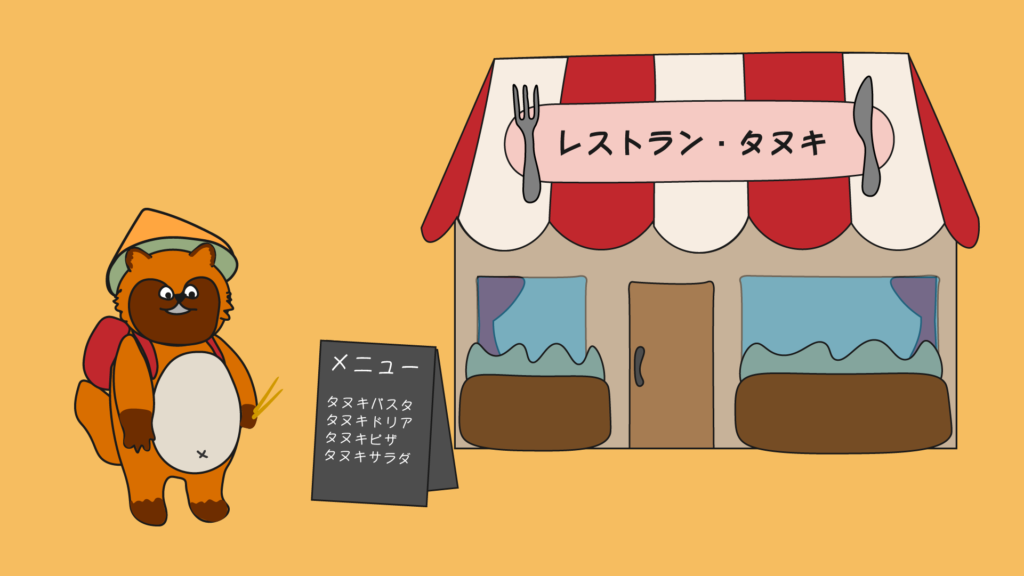How to order food at a restaurant in Japanese
Whether you’re a tourist or someone who’s just moved to Japan, one of the first things you’ll want to do is order food at a restaurant in Japanese! Japan has so much delicious food to offer that you won’t want to miss out. Although many restaurants have menus in English, it’s still a good idea to know how to order so you can make requests and have a pleasant time!

Stay tuned for a dialogue at the end, I will be ordering food at my favorite restaurant, Restaurant Tanuki!
Entering the restaurant
When you first enter the restaurant, you’ll already need to interact with the restaurant staff. Here are some common phrases that you’ll need to know!
いらっしゃいませ! – Irasshaimase! – Welcome!
This phrase is usually said by the wait staff when you first walk in. Don’t be startled if they shout in a loud voice, especially in ramen or other Japanese fast food restaurants.
何名様ですか? – nan mei sama desuka? – How many people are you?
If you arrive at the restaurant with other people, they will likely ask you this question to check the number of people.
おひとり様ですか?- ohitori sama desuka? – Will you be dining by yourself?
If you arrive at the restaurant by yourself, they’ll usually ask this question. Don’t be scared as a solo diner in Japan, it’s very common for people to eat out by themself.
_____名です。- _____ mei desu. – We are _____ people.
This is the answer to the question about how many people are in your group. You can insert any number in the blank.
あとから______人来ます。 – ato kara _____ nin kimasu. – there will be _____ more people coming.
If you have more people coming, you can let them know. This way they can seat you somewhere bigger from the beginning.
カウンター席にしますか? – kauntaa seki ni shimasuka? – would you like to sit at the counter?
In some restaurants, they may have seating at the counter. Especially if you’re a solo diner, they may ask you if you’d prefer to sit at this kind of seat.
Changing your seating
After being directed to your seat, you may decide that you’d rather sit somewhere else. Here are some phrases to change your seat.
奥に座らせて下さい。- oku ni suwarasete kudasai. – I’d prefer to sit further inside.
外に座らせて下さい。- soto ni suwarasete kudasai. – I’d prefer to sit outside.
窓際に座らせて下さい。- mado giwa ni suwarasete kudasai. – I’d like to sit by the window.
Calling the waiter’s attention
すみません! – sumimasen! or – Excuse me!
This is the best way to call the waiter’s attention. You can simply say this phrase and then say your request.
In some restaurants they have call buttons at each table. As soon as you press the button, the waiter will come to your table.
Asking for things and ordering
Vending machine ticket
In certain eateries, there might be a vending machine with menu items written on it. In these kinds of places you will pay and place your order at the machine, and bring the ticket to someone in the restaurant. These are usually self serve style and you’ll also seat yourself.
お飲み物は何にしますか?- onomimono wa nani ni shimasuka? – what would you like to drink?
This is a common question as soon as you sit down at izakayas (Japanese style tapas bars). Since it’s a drinking place, they’ll want to get your drinks first while you decide what to order.
Since there are more and more tourists coming to Japan, many restaurants now have English menus. This can make your experience much easier, so be sure to ask.
ご注文はお決まりですか?- gochuumon wa okimari desuka? – have you decided on your order?
When the waiter thinks you’re ready to order they will ask you if you’ve decided. This is a good time to make your order or ask further questions about the menu.
もう少し時間をください – mousukoshi jikan o kudasai – Please give me more time.
If you need more time to think about your order, you can ask for more time by saying this phrase.
____をください。- _____ o kudasai. – I would like to have _________
This is a useful phrase to ask for anything. You can put your order in the blank or other items like forks (フォーク fooku), knives (ナイフ naifu) , spoons (スプーン supuun), plates (お皿 osara), water (お水 omizu), and anything else you need.
_____のアレルギーがあります。_____ no arerugii ga arimasu – I have a _____ allergy
If you have food allergies, make sure to learn how to say your allergens in Japanese. These days, restaurants are very careful and have a detailed list of what’s in each menu item.
______が食べられません。_____ ga taberaremasen. – I can’t eat_____.
If you have things you can’t eat or want to avoid, you can say this phrase. Just look up the words you need for the food you can’t eat.
ベジタリアン・ビーガンです。- bejitarian/ biigan desu. – I’m vegetarian/vegan.
Being vegetarian or vegan is more common around the world, so Japanese people will understand what you mean if you say this phrase. Keep in mind that many Japanese dishes use fish stock, even if the rest of the dish is vegetarian.
おすすめは何ですか?- osusume wa nandesuka? – what is your recommendation?
Sometimes the best way to experience new flavors and cuisines is by asking for a recommendation. This way, you can try what the locals like to eat.
日替わりメニューは何ですか。- higawari menyuu wa nandesuka? – What’s today’s special?
Daily specials can be common in some restaurants so you might want to ask what it is.
めん/ご飯 大盛り/少なめでお願いします。- men/gohan oomori/sukuname de onegai shimasu. I’d like to have noodles/rice with a larger/smaller portion.
In places where they serve rice or noodles, there might be an option to get a bigger portion or a smaller portion.
トイレはどこですか?- toire wa doko desuka? – Where’s the bathroom?
This is one of the most important phrases to learn. This way, you’ll always know where the bathroom is.
以上でよろしいですか?- ijou de yoroshii desuka? – Will that be all?
Once it looks like you’re done ordering, the waiter will ask if you’re done ordering. Simply reply yes or no depending on the situation.
注文した物と違います。- chuumon shita mono to chigaimasu. – This is different from what I ordered.
If it clearly looks like they messed up your order, you can say this phrase. It’s very rare in Japan for these things to happen, but it’s useful to know.
すみません、ラストオーダーになります – sumimasen, rasuto oodaa ni narimasu. – excuse me, we’re taking the last orders before we close the kitchen.
If you’re staying late and enjoying some drinks, it’s common to lose track of time. The waiter might come around to the tables to say this phrase to let you know it’s the last chance to order more food.
Paying the bill and leaving the restaurant
お会計をお願いします。- okaikei o onegaishimas. – I’d like to have the bill.
This is a common phrase if you need your bill calculated, especially if you were at a conveyor belt sushi restaurant. Otherwise, they will normally place the receipt at the table.
カードは使えますか?- kaado wa tsukaemasuka? – Can I use my card?
Japan is a country that still uses cash in daily life. Make sure to ask, if you want to try using your card.
現金のみです。- genkin nomi desu – It’s cash only.
If you ask to use a credit or debit card, they may decline by saying this phrase. In more traditional restaurants they’ll usually only accept cash.
別々でお願いします。- betsu betsu de onegai shimasu. – We’d like to pay separately.
Splitting the bill can be done easily by using this phrase. 別 (betsu) means separate in Japanese.
ごちそうさまでした。- gochisou sama deshita. – Thank you for the food.
This is a classic phrase used during meal times. It gives appreciation for the food. You can tell the waiter or chef if you enjoyed the food.
とても美味しかったです。- totemo oishikatta desu. – It was very delicious.
Another way to give praise for the meal is by saying this phrase. The chef and waiter will be pleased if you enjoyed your meal.
ありがとうございました。- arigatou gozaimashita – Thak you very much.
When you are leaving the restaurant, the waiter will say “thanks” for deciding to come to the restaurant.
Cultural differences in a Japanese restaurant
There are several cultural differences in Japanese restaurants that might be surprising if you come from other countries. Here are some of the most important ones to know:
No tip!
There is no tipping culture in Japan. All the employees are being paid adequately for their service so it’s not necessary! Also, because Japanese society is already a service oriented society, you can expect great service even if there are no monetary benefits for the employees.
Customer goes to a cashier to pay
Many aspects of dining at a Japanese restaurant is self-service. Payments are usually made at the cashier desk. When they bring the meal, they will put a receipt on your table. Take the receipt to the cashier desk, and the bill will be sorted out.
Set meals
Especially during lunch time, set meals are very common. These will offer great value and you’ll be able to combine multiple dishes. The other common thing that’s on offer are drink sets, where you can combine all-you-can-drink sodas, teas, and other beverages to your meal.
Menu is sometimes written on the walls
Another thing that might be surprising is that in traditional style eateries, they sometimes write the menu with prices on the walls. You won’t receive any menus but instead you’ll have to look around.
Long lines are common for popular restaurants
If you see a long line at a restaurant, it probably means that it is very good. Japanese people love to wait in long lines so be on the lookout. The wait time can sometimes be an hour or more!
Practice dialogue: Tanuki goes to a restaurant!
Here is a practice dialogue using the various restaurant phrases. Tanuki will be marked with a “T” and the waiter will be a “W”.
W:いらっしゃいませ!おひとり様ですか?
Irasshaimase! Ohitori sama desuka?
Welcome! Will you be dining by yourself?
T:はい。
Hai.
Yes.
W:カウンター席にしますか?
Kauntaa seki ni shimasu ka?
Would you like to sit at the counter seat?
T:はい、お願いします。
Hai, onegaishimasu.
Yes, please.
Tanuki gets seated…
T:すみません!
Sumimasen!
Excuse me!
W:はい、ご注文はお決まりですか?
Hai, gochuumon wa okimaridesuka?
Yes, have you decided on your order?
T:タヌキパスタをください。天かすをたっぷり乗せて下さい。
Tanuki pasuta o kudasai. Tenkasu o tappuri nosetekudasai
I would like the Tanuki pasta. Please put lots of tenkasu (fried batter).
W:はい、かしこまりました。
Hai, kashikomarimashita.
Yes, ok.
Meal arrives…
W: タヌキパスタです。
Tanuki pasuta desu.
Here is the Tanuki pasta.
T: ありがとうございます。
Arigatougozaimasu.
Thank you.
Tanuki is ready to pay…
T: お会計お願いします。
Okaikei onegaishimasu.
I’d like to have the bill.
W:900円になります。
Kyuuhyaku en ni narimasu.
That will be 900 yen.
Tanuki hands the money…
W:ありがとうございました。
Arigatou gozaimashita.
Thank you.
T: ごちそうさまでした!
Gochisousamadeshita!
Thank you for the food.
I hope this covers everything you need on how to order food at a restaurant in Japanese! If you’re interested in other Japanese language content, check out How to say sorry in Japanese: 10 useful phrases or How to say goodbye in Japanese: Beyond sayounara
~Tanuki





